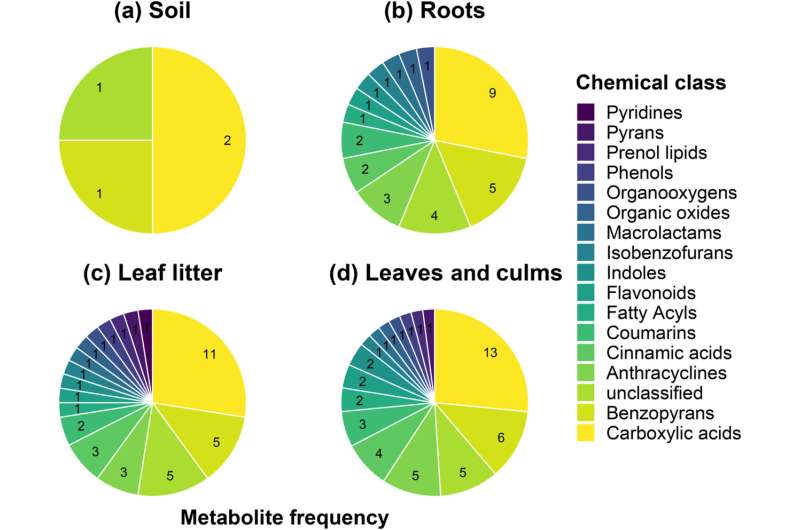This article has been reviewed according to Science X's editorial process and policies. Editors have highlighted the following attributes while ensuring the content's credibility:
fact-checked
peer-reviewed publication
trusted source
proofread
Invasive grass in Texas uses chemical warfare to crowd out native species

An invasive grass causing havoc in Texas and contributing to wildfires packs a one-two wallop against native plants. Guinea grass uses a combination of crowding that blocks out light from growing seedlings and what amounts to a chemical warfare in soil that is toxic to native plants, according to a new study by researchers at The University of Texas at Austin.
The findings are published in the journal Ecosphere.
Guinea grass is one of the most ecologically damaging invasive species in the world, arriving in South Texas from Africa more than 100 years ago, to help feed cattle. In the past 20 years, it has spread aggressively across the region and can now be found along roadsides as far north as Austin, bringing with it the risk of more frequent, high-intensity wildfires.
The researchers said knowing about how an invasive species takes over an area is an important step in figuring out how to control and reduce it in the environment.
"The shading and the chemical toxins are each effective at pushing out native plants on their own, but combined, the negative effects increased dramatically," said Colin Morrison, a graduate student in the Department of Integrative Biology who is the lead author on the paper.
Initial studies led by co-author, and UT Austin post-doctoral researcher, Liz Bowman showed that guinea grass inhibits growth of other grasses, and invasion alters soil microbial communities compared to pre-invasion communities. The new paper, led by Morrison, indicates that these changes could be due to chemical weapons that guinea grass produces and releases into the soil.
At UT Austin's Brackenridge Field Laboratory (BFL), the researchers used a combination of field testing, greenhouse experiments and chemistry analyses to observe species interactions and extract and analyze the unique cocktail of toxins in Guinea grass, which includes 2-hydroxyphenylacetic acid, a toxin used by other plants to suppress their competitors.
"Guinea grass escaped its natural enemies and stressors in Africa. In the invaded range, its self-seeding, has duplicated genomes and may have novel relationships with certain microbes in the soil. And it has chemical weapons," said Robert Plowes, a research scientist and author on the paper. "Its seeds are also very good at sticking to trucks, ranch equipment and roadside mowers, so it spreads easily."
Plowes is from Zimbabwe, and he is working with other researchers in Kenya and South Africa to investigate natural control methods to fight Guinea grass. For example, previous research led by Aaron Rhodes, a BFL research associate, discovered a potential role for specialized insects in its native range that help keep Guinea grass from getting out of control. BFL researchers also work with Texas ranchers to help them understand how Guinea grass spreads, how soil disturbance can allow it to move in and how proactive range management and restoration can potentially keep it out.
More information: Colin R. Morrison et al, Adding insult to injury: Light competition and allelochemical weapons interact to facilitate grass invasion, Ecosphere (2023). DOI: 10.1002/ecs2.4438
Journal information: Ecosphere
Provided by University of Texas at Austin





















